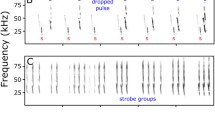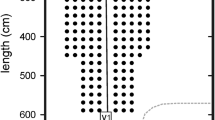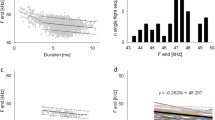Abstract
We compared the influence of conspecifics and clutter on echolocation and flight speed in the bat Myotis daubentonii. In a large room, actual pairs of bats exhibited greater disparity in peak frequency (PF), minimum frequency (F MIN) and call period compared to virtual pairs of bats, each flying alone. Greater inter-individual disparity in PF and F MIN may reduce acoustic interference and/or increase signal self-recognition in the presence of conspecifics. Bats flying alone in a smaller flight room, to simulate a more cluttered habitat as compared to the large flight room, produced calls of shorter duration and call period, lower intensity, and flew at lower speeds. In cluttered space, shorter call duration should reduce masking, while shorter call period equals more updates to the bat’s auditory scene. Lower intensity likely reflects reduced range detection requirements, reduced speed the demands of flying in clutter. Our results show that some changes (e.g. PF separation) are associated with conspecifics, others with closed habitat (e.g. reduced call intensity). However, we demonstrate that call duration, period, and flight speed appear similarly influenced by conspecifics and clutter. We suggest that some changes reduce conspecific interference and/or improve self-recognition, while others demonstrate that bats experience each other like clutter.


Similar content being viewed by others
Abbreviations
- BW:
-
Call bandwidth (F MAX −F MIN)
- FM:
-
Frequency-modulated
- F MAX :
-
Maximum call frequency (−10 dB from PF)
- F MIN :
-
Minimum call frequency (−10 dB from PF)
- JAR:
-
Jamming avoidance response
- PF:
-
Peak frequency
References
Bartonička T, Řehák Z, Gaisler J (2007) Can pipistrelles, Pipistrellus pipistrellus (Schreber, 1774) and Pipistrellus pygmaeus (Leach, 1825), foraging in a group, change parameters of their signals? J Zool 272:194–201
Bates ME, Stamper SA, Simmons JA (2008) Jamming avoidance response of big brown bats in target detection. J Exp Biol 211:106–113
Biscardi S, Orprecio J, Fenton MB, Tsoar A, Ratcliffe JM (2004) Data, sample sizes and statistics affect the recognition of species of bats by their echolocation calls. Acta Chiropterol 6:347–363
Bogdanowicz W (1994) Myotis daubentonii. Mamm Species 475:1–9
Bregman AS (1990) Auditory scene analysis: the perceptual organization of sound. University of Chicago, Chicago
Brinkløv S, Jakobsen L, Ratcliffe JM, Kalko EKV, Surlykke A (2011) Echolocation call intensity and directionality in flying short-tailed fruit bats, Carollia perspicillata (Phyllostomidae). J Acoust Soc Am 129:427–435
Cherry EC (1953) Some experiments on the recognition of speech, with one and with two ears. J Acoust Soc Am 25:975–979
Chiu C, Xian W, Moss CF (2008) Flying in silence: echolocating bats cease vocalizing to avoid sonar jamming. Proc Natl Acad Sci USA 105:13116–13121
Chiu C, Xian W, Moss CF (2009) Adaptive echolocation behaviour in bats for the analysis of auditory scenes. J Exp Biol 212:1392–1404
Dietz C, von Helversen O, Nill D (2009) Bats of Britain, Europe and northwest Africa. A and C Black, London
Fenton MB (1990) The foraging behaviour and ecology of animal-eating bats. Can J Zool 68:411–422
Gillam EH (2007) Eavesdropping by bats on the feeding buzzes of conspecifics. Can J Zool 85:795–801
Habersetzer J (1981) Adaptive echolocation sounds in the bat Rhinopoma hardwickei: a field study. J Comp Physiol A 144:559–566
Hartley DJ (1992) Stabilization of perceived echo amplitudes in echolocating bats. II. The acoustic behavior of the big brown bat, Eptesicus fuscus, when tracking moving prey. J Acoust Soc Am 91:1132–1149
Hiryu S, Bates ME, Simmons JA, Riquimaroux H (2010) FM echolocating bats shift frequencies to avoid broadcast–echo ambiguity in clutter. Proc Natl Acad Sci USA 107:7048–7053
Hurlbert SH (1984) Pseudoreplication and the design of ecological field experiments. Ecol Monogr 54:187–211
Ibáñez C, Juste J, Lopez-Wilchis R, Nunez-Garduno A (2004) Habitat variation and jamming avoidance in echolocation calls of the sac-winged bat (Balantiopteryx plicata). J Mamm 85:38–42
Jakobsen L, Surlykke A (2010) Vespertilionid bats control the width of their biosonar sound beam dynamically during prey pursuit. Proc Natl Acad Sci USA 107:13930–13935
Jakobsen L, Ratcliffe JM, Surlykke A (2013) Convergent acoustic field of view in echolocating bats. Nature 493:93–96
Kalko EKV, Schnitzler H-U (1989) The echolocation and hunting behavior of Daubenton’s bat, Myotis daubentonii. Behav Ecol Sociobiol 24:225–238
Kick SA, Simmons JA (1984) Automatic gain control in the bat’s sonar receiver and the neuroethology of echolocation. J Neurosci 4:2725–2737
Miller LA, Degn HJ (1981) The acoustic behaviour of four species of vespertilionid bats studied in the field. J Comp Physiol 142:67–74
Moss CF, Schnitzler H-U (1995) Behavioral studies of auditory information processing. In: Fay RR, Popper AN (eds) Hearing by bats. Springer, New York, pp 87–145
Norberg UM, Rayner JMV (1987) Ecological morphology and flight in bats (Mammalia; Chiroptera): wing adaptations, flight performance, foraging strategy and echolocation. Phil Trans R Soc Lond B 316:335–427
Nørum U, Brinkløv S, Surlykke A (2012) New model for gain control of signal intensity to object distance in echolocating bats. J Exp Biol 215:3045–3054
Obrist MK (1995) Flexible bat echolocation: the influence of individual, habitat and conspecifics on sonar signal design. Behav Ecol Sociobiol 36:207–219
Ratcliffe JM, Dawson JW (2003) Behavioural flexibility: the little brown bat, Myotis lucifugus, and the northern long-eared bat, M. septentrionalis, both glean and hawk prey. Anim Behav 66:847–856
Ratcliffe JM, ter Hofstede HM, Avila-Flores R, Fenton MB, McCracken G, Biscardi S, Blasko J, Gillam E, Orpecio J, Spanjer G (2004) Conspecifics influence call design in the Brazilian free-tailed bat, Tadarida brasiliensis. Can J Zool 82:966–971
Ratcliffe JM, Jakobsen L, Kalko EKV, Surlykke A (2011) Frequency alternation and an offbeat rhythm indicate foraging behavior in the echolocating bat, Saccopteryx bilineata. J Comp Physiol A 197:413–423
Ratcliffe JM, Elemans CPH, Jakobsen L, Surlykke A (2013) How the bat got its buzz. Biol Lett 9:20121031
Schnitzler H-U, Kalko EKV (2001) Echolocation by insect-eating bats. Bioscience 51:557–569
Siemers BM, Schnitzler H-U (2004) Echolocation signals reflect niche differentiation in five sympatric congeneric bat species. Nature 429:657–661
Siemers BM, Stilz P, Schnitzler H-U (2001) The acoustic advantage of hunting at low heights above water: behavioural experiments on the European ‘trawling’ bats Myotis capaccinii, M. dasycneme and M. daubentonii. J Exp Biol 204:3843–3854
Simmons NB (2005) Order Chiroptera. In: Wilson DE, Reeder DM (eds) Mammal species of the world: a taxonomic and geographic reference, vol 1, 3rd edn. Johns Hopkins University Press, Baltimore, pp 312–529
Surlykke A, Moss CF (2000) Echolocation behaviour of big brown bats, Eptesicus fuscus, in the field and the laboratory. J Acoust Soc Am 108:2419–2429
Surlykke A, Pedersen SB, Jakobsen L (2009) Echolocating bats emit a highly directional sonar sound beam in the field. Proc R Soc Lond B 276:853–860
Ulanovsky N, Moss CF (2008) What the bat’s voice tells the bat’s brain. Proc Natl Acad Sci USA 105:8491–8498
Ulanovsky N, Fenton MB, Tsoar A, Korine C (2004) Dynamics of jamming avoidance in echolocating bats. Proc R Soc Lond B 271:1467–1475
Acknowledgments
We thank L. Jakobsen and B. Charlton for Matlab scripts. We thank S. Brinkløv, J. Christensen-Dalsgaard, A. Denzinger, B. Fenton, A. Surlykke for comments on the manuscript. L. Faber and T. Bojesen assisted with experiments. This study was funded by Danish Natural Sciences Research Council (FNU) grants to JMR and adhered to the legal requirements of Denmark and all institutional guidelines.
Author information
Authors and Affiliations
Corresponding author
Rights and permissions
About this article
Cite this article
Fawcett, K., Ratcliffe, J.M. Clutter and conspecifics: a comparison of their influence on echolocation and flight behaviour in Daubenton’s bat, Myotis daubentonii . J Comp Physiol A 201, 295–304 (2015). https://doi.org/10.1007/s00359-014-0977-0
Received:
Revised:
Accepted:
Published:
Issue Date:
DOI: https://doi.org/10.1007/s00359-014-0977-0




